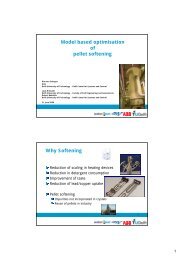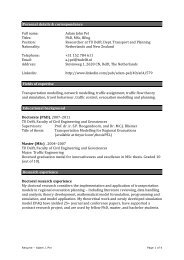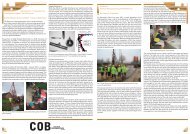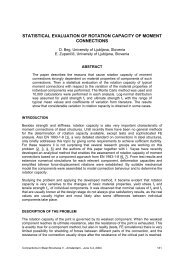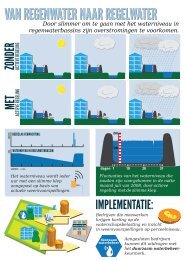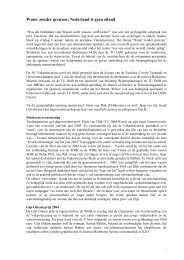Structural Design of Pavements PART VI Structural ... - TU Delft
Structural Design of Pavements PART VI Structural ... - TU Delft
Structural Design of Pavements PART VI Structural ... - TU Delft
You also want an ePaper? Increase the reach of your titles
YUMPU automatically turns print PDFs into web optimized ePapers that Google loves.
7<br />
3. Deflection measurement tools:<br />
The deflection device that currently receives the highest popularity is the falling weight<br />
deflectometer (FWD). Nevertheless other deflection measuring devices like the Benkelman<br />
Beam (BB) and the Lacroix Deflectograph (LD) are still used at different places at the world.<br />
Especially the Benkelman Beam deserves attention since this low cost device (the price is<br />
approximately 1/30 th <strong>of</strong> the price <strong>of</strong> a falling weight deflectometer) is used in many<br />
developing countries. The principles <strong>of</strong> these three devices are given elsewhere [1], here only<br />
the main features will be described.<br />
3.1 Falling weight deflectometer:<br />
The principle <strong>of</strong> the FWD is schematically shown in figure 2.<br />
Figure 2: Principle <strong>of</strong> the falling weight deflectometer.<br />
A weight with a certain mass drops from a certain height on a set <strong>of</strong> springs (normally rubber<br />
buffers) which are connected to a circular loading plate which transmits the load pulse to the<br />
pavement. Load cells are used to monitor the magnitude and duration <strong>of</strong> the load pulse. The<br />
magnitude <strong>of</strong> the load pulse can vary between the 30 and 250 kN depending on the mass <strong>of</strong><br />
the falling weight and the falling height. The duration <strong>of</strong> the load pulse is mainly dependent on<br />
the stiffness <strong>of</strong> the rubber buffers. Usually pulse duration between 0.02 and 0.035 s are<br />
measured.<br />
The surface deflections are measured with so called geophones. These are velocity transducers<br />
which measure the vertical displacement speed <strong>of</strong> the surface. By integration the displacements<br />
are obtained.<br />
Since the electronic circuits are only opened a very short moment before the weight hits the<br />
buffers, the influence <strong>of</strong> passing traffic on the magnitude <strong>of</strong> the deflections is eliminated; only<br />
the displacements due to the impact load are measured.<br />
The advantage <strong>of</strong> the FWD is the short duration <strong>of</strong> the load pulse comparable to the duration<br />
<strong>of</strong> the load pulse caused by a truck driving at approximately 50 km/h. Because <strong>of</strong> the short<br />
pulse duration, the influence <strong>of</strong> viscous effects can be neglected.<br />
One should however be cautious when the modulus <strong>of</strong> a saturated subgrade with a high<br />
ground water level is determined from the deflection measurement results. In that case one<br />
might measure the bulk modulus K <strong>of</strong> the subgrade which, in case <strong>of</strong> a fully saturated<br />
subgrade, can be high. Because road materials are very much sensitive for shear, this high<br />
bulk modulus value gives a wrong idea about the real stiffness <strong>of</strong> the material. This can be<br />
illustrated with the following simple example.



